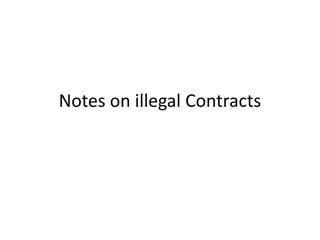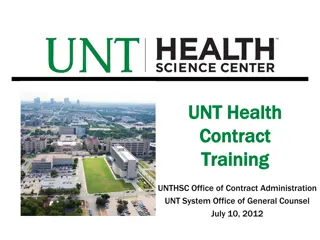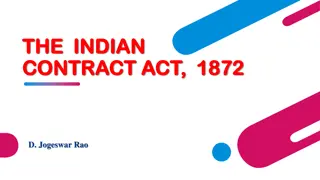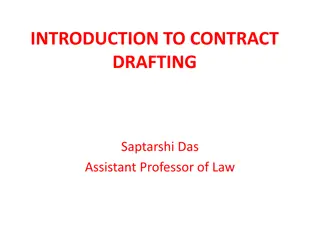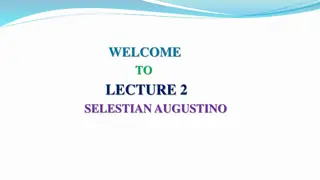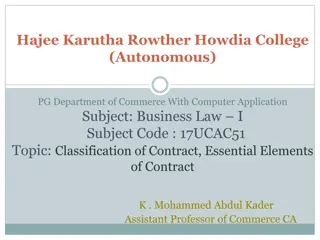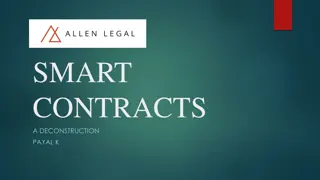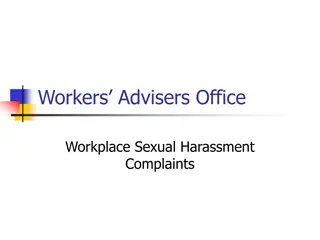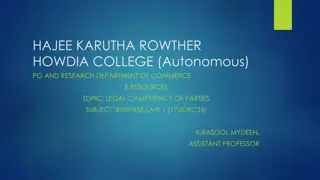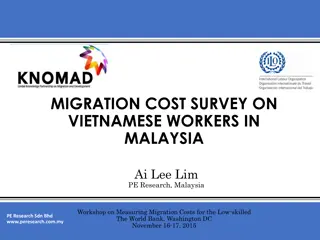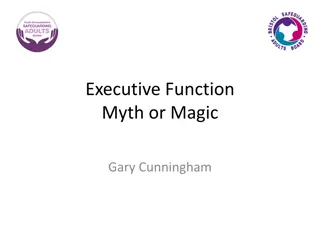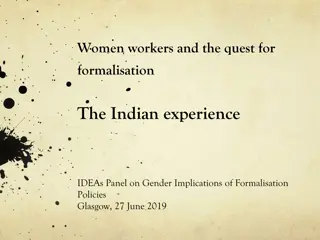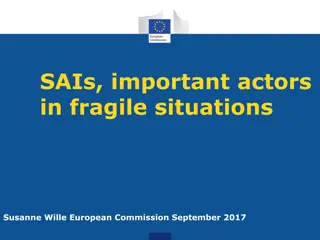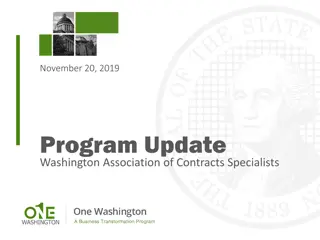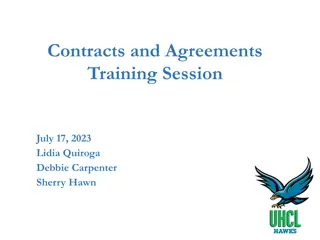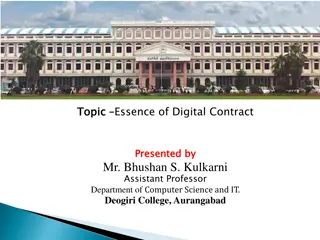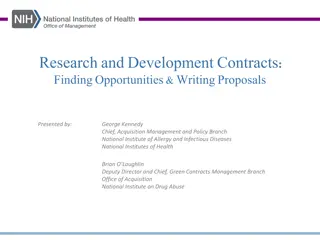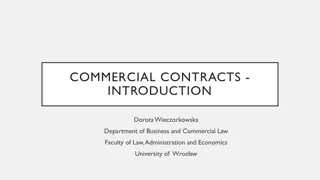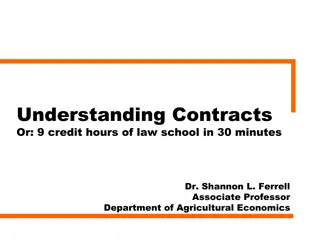Understanding Executive Order 13495: Nondisplacement of Qualified Workers under Service Contracts
Executive Order 13495 establishes a policy where successor contractors must offer employment to qualified workers from predecessor contracts. The aim is to maintain an experienced workforce during transitions, benefiting efficiency and service delivery. Implementing regulations by DOL and FAR ensure compliance with the order for service contracts covered by the Service Contract Act.
Download Presentation

Please find below an Image/Link to download the presentation.
The content on the website is provided AS IS for your information and personal use only. It may not be sold, licensed, or shared on other websites without obtaining consent from the author. Download presentation by click this link. If you encounter any issues during the download, it is possible that the publisher has removed the file from their server.
E N D
Presentation Transcript
NONDISPLACEMENT OF QUALIFIED WORKERS UNDER SERVICE CONTRACTS EXECUTIVE ORDER 13495 2
Agenda INTRODUCTION COVERAGE CONTRACTING AGENCY & PREDECESSOR CONTRACTOR OBLIGATIONS SUCCESSOR CONTRACTOR OBLIGATIONS COMPLAINTS FEDERAL AGENCY EXEMPTION (WAIVER) PROCEDURES ENFORCEMENT 3
Introduction Executive Order (E.O.) 13495 President Obama signed E.O. 13495 Nondisplacement of Qualified Workers Under Service Contracts on January 30, 2009. E.O. 13495 establishes a general policy of the Federal Government concerning service contracts and solicitations for service contracts for performance of the same or similar services at the same location. Specifically, the E.O. mandates the inclusion of a contract clause entitled Nondisplacement of Qualified Workers in covered contracts requiring the successor contractor and its subcontractors to offer employees working under the predecessor contract whose employment will be otherwise terminated, a right of first refusal of employment under the successor contract in positions for which they are qualified. 4
Purpose The Federal Government s procurement interests in economy and efficiency are served when a successor contractor hires the predecessor s employees. A carryover work force provides the Federal Government the benefits of an experienced and trained workforce familiar with the Federal Government s personnel, facilities, and requirements, and Reduces disruption to the delivery of services during the period of transition between the predecessor and successor contractors. 5
Implementing Regulations The DOL and FAR regulations implementing E.O. 13495 took effect on January 18, 2013, and apply to solicitations issued on or after that effective date. DOL Regulations 29 C.F.R. Part 9. DOL Contract Clause 29 C.F.R. Part 9, Appendix A. FAR Regulations 48 C.F.R. Part 22, Subpart 22.12. FAR Contract Clause 48 C.F.R. Part 52.222-17. 6
Coverage SCA covered contracts & service employees E.O. 13495 defines service contract or contract to mean any contract or subcontract for services entered into by the Federal Government or its contractors covered by the Service Contract Act (SCA). Each federal agency solicitation and each resulting contract that succeeds such a contract or subcontract for the same or similar services at the same location must include the Nondisplacement of Qualified Workers contract clause (FAR 48 C.F.R. 52.222-17), unless a specific exception applies. Same or similar service means a service that is either identical to or has one or more characteristics that are alike in substance to a service performed at the same location on a contract that is being replaced by the Federal Government or on a subcontract that is being replaced by a contractor on a Federal service contract. 29 C.F.R. 9.2. The E.O. s nondisplacement requirements apply to service employees as defined by the SCA. Under the SCA, all employees performing work on the contract are considered service employees unless they are defined as executive, administrative, or professional employees exempt under the FLSA and its regulations at 29 C.F.R. Part 541. 7
Coverage contd E.O. 13495, by its terms, does not apply to: Contracts or subcontracts under the simplified acquisition threshold (currently $150,000). FAR 48 C.F.R. 22.1203-2(a)(1); seealso FAR 48 C.F.R. Part 13. Contracts or subcontracts awarded under 41 U.S.C. chapter 85, Committee for Purchase from People Who Are Blind or Severely Disabled (traditionally known as the Javits-Wagner-O Day Act); Agreements for the operation of vending facilities in Federal buildings entered into pursuant to the preference regulations issued under the Randolph-Sheppard Act (20 U.S.C. 107), which authorizes priority to be given to licensed blind persons); or Guard, elevator operator, messenger, or custodial services provided to the Federal Government under contracts or subcontracts with sheltered workshops employing the severely handicapped as described in 40 U.S.C. 593 (which provides protection for certain veterans preference employees). Service employees who were hired to work under a federal service contract and one or more nonfederal service contracts as part of a single job, provided that the service employees were not deployed in a manner that was designed to avoid the purposes of the E.O. and its implementing regulations. 8
Contracting Agency and Predecessor Contractor Obligations Nondisplacement Contract Clause E.O. 13495 requires the contracting agency to include the contract clause Nondisplacement of Qualified Workers in solicitations for and service contracts that succeed contracts for performance of the same or similar work at the same location. 29 C.F.R. 9.11(a) and FAR 48 C.F.R. 22.1207 and 52.222-17. FAR, at 48 C.F.R. 22.1207, directs that the contracting officer shall insert the clause at 52.222-17, Nondisplacement of Qualified Workers, in solicitations and contracts for (1) service contracts (2) that succeed contracts for performance of the same or similar work at the same location and (3) that are not exempted by 22.1203-2 or waived in accordance with 22.1203-3. In addition, 29 C.F.R. Part 9, Appendix A, shall be inserted in all such solicitations and contracts that are not subject to the FAR. 9
Contracting Agency and Predecessor Contractor Obligations cont d Notification to contractors and service employees 29 C.F.R. 9.11(b); FAR 48 C.F.R. 22.1205. The contracting officer shall direct the predecessor contractor to provide written notice to the service employees employed on the predecessor contract of their possible right to an offer of employment with the successor contractor. The written notice shall be Posted in a conspicuous place at the worksite; or Delivered to the service employees individually. If such delivery is via email, the notification must result in an electronic delivery receipt or some other reliable confirmation that the intended recipient received the notice. 10
Contracting Agency and Predecessor Contractor Obligations cont d Appendix B to 29 C.F.R. Part 9 provides a notice that contracting officers may advise contractors to use to provide the written notice. 29 C.F.R. 9.11(b); FAR 48 C.F.R. 22.1205(b). Where a significant portion of the predecessor contractor s workforce is not fluent in English, the contractor must provide the notice in English and the language(s) with which service employees are more familiar. (English and Spanish versions of the notice are available on the WHD web site at http://www.dol.gov/whd/govcontracts). 11
Contracting Agency and Predecessor Contractor Obligations cont d Predecessor s certified service employee lists 29 C.F.R. 9.12(e) and FAR 48 C.F.R. 22.1204. Not less than 30 days before completion of the contract, the predecessor contractor is required to furnish to the contracting officer a certified list of the names of all service employees working under the contract and its subcontracts at the time the list is submitted. The certified list must also contain anniversary dates of employment of each service employee under the contract and subcontracts for services. The information on this list is the same as that on the seniority list required by the SCA contract clause at FAR 48 C.F.R. 52.222-41(n). When there are changes to the workforce after submission of the 30-day list, the predecessor contractor shall submit a revised certified list not less than 10 days prior to contract performance completion. The contracting officer shall provide the certified service employee list to the successor contractor immediately upon receipt of the certified service employee list, but not before contract award and, if requested, also provide the list to employees or their authorized representatives. 12
Successor Contractor Obligations Bona fide offers of employment and service employees right of first refusal 29 C.F.R. 9.2 and 9.12; FAR 48 C.F.R. 22.1202(a), 22.1203-4, and 52.222- 17(b). Make a bona fide express offer of employment on the successor contract to qualified service employees employed under the predecessor contract whose employment will be terminated as a result of award of the successor contract or the expiration of the contract under which the service employees were hired, and Give each such individual a right of first refusal in response to the offer of employment under the successor contract. Such offers are required to be for employment in positions for which the service employees are qualified. 13
Successor Contractor Obligations cont d There shall be no employment opening under a covered contract, and the contractor and any subcontractors shall not offer employment under such a contract, to any person prior to having complied fully with this obligation. 29 C.F.R. Part 9, Appendix A, paragraph (a); FAR 48 C.F.R. 52.222-17(b)(2) and (c). The obligation to offer employment shall cease upon the employee s first refusal of a bona fide offer of employment on the contract. 29 C.F.R. 9.12(b). 14
Successor Contractor Obligations cont d Method of job offer FAR 48 C.F.R. 22.1203-4; 29 C.F.R. 9.12(b). The offer may be made in writing or orally, and To ensure that the offer is effectively communicated, the successor contractor should take reasonable efforts to make the offer in a language that each worker understands. Each bona fide express offer of employment made to a qualified service employee on the predecessor contract must state a time limit of not less than 10 days for an employee response. Prior to the expiration of the 10-day period, the contractor is prohibited from offering employment on the contract to any other person, except as otherwise allowed or required under provisions set forth in E.O. 13495 and its implementing regulations. 29 C.F.R. 9.12(b)(2); FAR 48 C.F.R. 22.1203-4. 15
Successor Contractor Obligations cont d Bona fide offer of employment As a general matter, an offer of employment to a position on the successor contract will be presumed to be bona fide; even if it is not for a position similar to the one the employee previously held, but is one for which the employee is qualified, and even if it is subject to different employment terms and conditions, including changes to pay or benefits, than those of the position the employee held with the predecessor contractor. 16
Successor Contractor Obligations cont d Employee eligibility & qualifications E.O. 13495 generally requires that successor contractors performing on federal service contracts offer a right of first refusal of suitable employment, i.e., a job for which the employee is qualified. 29 C.F.R. 9.12(a). A contractor must base its decision regarding an employee s qualifications on written credible information provided by a knowledgeable source such as the predecessor contractor, the local supervisor, the employee, or the contracting agency. 29 C.F.R. 9.12(c)(4). The successor contractor may utilize employment screening processes only when such processes are provided for by the contracting agency, are conditions of the service contract, and are consistent with E.O. 13495. 29 C.F.R. 9.12(b)(1); FAR 48 C.F.R. 22.1203-4. 17
Successor Contractor Obligations cont d Similarly, an employee could demonstrate eligibility by producing a paycheck stub identifying the work location and dates worked. 29 C.F.R. 9.12(a)(3). The successor contractor s obligation to offer a right of first refusal exists even if the successor contractor has not been provided a list of the predecessor contractor s employees or the list does not contain the names of all persons employed during the final month of contract performance. 29 C.F.R. 9.12(a)(2). The successor contractor and its subcontractors shall decide any question concerning an employee s qualifications based on the individual s education and employment history, with particular emphasis on the employee s experience on the predecessor contract. 29 C.F.R. 9.12(b)(4); FAR 48 C.F.R. 22.1203-4. 18
Successor Contractor Obligations cont d Reduced staffing FAR 48 C.F.R. 22.1203-6; 29 C.F.R. 9.12(d). A successor contractor and its subcontractors may employ fewer service employees than the predecessor contractor employed in connection with performance of the work. Thus, the successor contractor need not offer employment on the contract to all service employees on the predecessor contract, but must offer employment only to the number of eligible service employees the successor contractor believes necessary to meet its anticipated staffing pattern, except that: Where a successor contractor does not initially offer employment to all the predecessor contract service employees, the obligation to offer employment shall continue for 90 days after the successor contractor s first date of performance on the contract. 29 C.F.R. 9.12(d)(3) and FAR 48 C.F.R. 22.1203-6. 19
Successor Contractor Obligations cont d The contractor s obligation to offer employment opportunities and to implement the right of first refusal under E.O. 13495 and the implementing regulations will end when all of the predecessor contract employees have received a bona fide job offer (including stating the time within which the employee must accept such offer, which must be no less than 10 days) or the 90-day window of obligation has expired. (Three examples that demonstrate this principle are provided at 29 C.F.R. 9.12((d)(1)(ii)(A), (B) & (C)). DOL guidance at 29 C.F.R. 9.12(d) addresses circumstances in which reduced staffing can occur. The contractor and its subcontractors determine the number of service employees necessary for efficient performance of the successor contract, and May elect to employ fewer service employees than the predecessor contractor employed in connection with performance of the work, for bona fide staffing or work assignment reasons. The successor contractor, subject to certain restrictions such as under non-discrimination laws and regulations will determine which of the predecessor contractor s employees will receive its offers of employment while the process described above is implemented. 20
Exceptions contd Under the successor contract, a successor contractor or its subcontractors may employ any of its current service employees who: o Have worked for the successor contractor or its subcontractors for at least three months immediately preceding the commencement of the successor contract, and would otherwise face lay-off or discharge. A successor contractor or its subcontractors are not required to offer employment to any service employee of the predecessor contractor who will be retained by the predecessor contractor. The successor contractor must presume that all service employees hired to work under a predecessor s federal service contract will be terminated as a result of the award of the successor contract, absent an ability to demonstrate a reasonable belief to the contrary that is based upon credible information provided by a knowledgeable source such as the predecessor contractor or the employee. 21
Exceptions contd A contractor or subcontractor is not required to offer employment to any employee of the predecessor contractor for whom the successor contractor or any of its subcontractors reasonably believes, based on the particular service employee s past performance, has failed to perform suitably on the job. The contractor must presume that all employees working under the predecessor contract in the last month of performance performed suitable work on the contract, absent an ability to demonstrate a reasonable belief to the contrary, that is: o Based upon written credible information provided by a knowledgeable source such as the predecessor contractor and its subcontractors, the local supervisor, the employee, or the contracting agency. (See examples at 29 C.F.R. 9.12(c)(4)(ii)(B). o The performance determination must be made on an individual basis for each employee. Information regarding the general performance of the predecessor contractor is not sufficient to claim this exception. FAR 48 C.F.R. 22.1203-5(a)(2) and 29 C.F.R. 9.12(c)(4). 22
Exceptions contd Compliance with any other E.O., regulation, or law of the United States . All applicable laws and executive orders must be satisfied in tandem with, and if necessary prior to, the requirements of E.O. 13495 and its implementing regulations. 48 C.F.R. 22.1202(b). For example: o The requirements of the HUBZone Program (see FAR 48 C.F.R. 19.13), o E.O. 11246 (Equal Employment Opportunity), and o The Vietnam Era Veterans Readjustment Assistance Act of 1974. 23
Subcontracts The nondisplacement contract clause required to be included in covered contracts includes a section concerning subcontracts. In every subcontract entered into to perform services under this contract, the contractor will include provisions that ensure that each subcontractor will honor the nondisplacement contract clause requirements. Subcontracts must also include a provision to ensure that the subcontractor will provide the contractor with the information about its employees needed by the contractor to comply with the requirement to furnish the list(s) of names and anniversary dates of service employees working under the contract and its subcontracts during the last month of contract performance. 24
Federal Agency Exemption (Waiver) Procedures Authority to Exempt Contracts : 29 C.F.R. 9.4 and FAR 48 C.F.R. 22.1203.3 The head of a contracting department or agency, or, under the FAR, the senior procurement executive, without delegation, may waive the application of some or all of the provisions of E.O. 13495 and its implementing regulations: o If, he/she finds that the application of any of the requirements of the E.O and its implementing regulations would not serve the purposes of E.O. 13495, or would impair the ability of the Federal Government to procure services on an economical and efficient basis. 25
Agency Exemption contd Such executive waivers, exempting specified procurement actions from the E.O. and related regulatory requirements, may be made for: o a contract, subcontract, or purchase order, or o with respect to a class of contracts, subcontracts, or purchase orders. 29 C.F.R. 9.4(d)(1); and FAR 48 C.F.R. 22.1203-3(a). 26
Agency Exemption contd The senior procurement executive shall not redelegate this waiver authority. FAR 48 C.F.R. 22.1203-3(a). In order for such a federal agency waiver to be operative, a written analysis supporting the waiver determination must be completed by the solicitation date. If the written analysis supporting exemption by an agency waiver is not completed by the contract solicitation date, the waiver is inoperative. The written analysis must be retained in accordance with FAR 48 C.F.R. 4.805. 27
Agency Exemption contd Notification to workers and DOL When an agency exercises its waiver authority with respect to any contract, subcontract, or purchase order, the contracting officer shall direct the contractor to notify affected workers and their collective bargaining representative in writing, of the agency s determination. 28
Agency Exemption contd Notification to workers and DOL Where a contracting agency waives application to a class of contracts, subcontracts, or purchase orders, the contracting officer shall, with respect to each individual solicitation, direct the contractor to notify incumbent workers and their collective bargaining representatives of the agency s determination. The agency shall notify the DOL of its waiver decision and provide the DOL with a copy of its written analysis. The waiver decision and related written analysis shall be sent to the following address: U.S. Department of Labor, Wage and Hour Division, Branch of Government Contracts Enforcement, 200 Constitution Avenue, N.W., Room S-3006, Washington, D.C. 20210, or by email to: Displaced@dol.gov 29
Recordkeeping The nondisplacement contract clause requires that Contractor and subcontractor shall maintain the following records (regardless of format, e.g., paper or electronic) of its compliance with this clause for not less than a period of three years from the date the records were created. 29 C.F.R. Part 9, Appendix A, paragraph (g); FAR 48 C.F.R. 52.222-17(f). DOL regulatory requirements are set forth in 29 C.F.R. 9.12(f) and at FAR 48 C.F.R. 52.222-17(f), and require the following: The contractor (and subcontractors) shall maintain copies of any written offers of employment or a contemporaneous written record of any oral offers of employment, including: o The date, location, and attendance roster of any employee meeting(s) at which the offers were extended, and a summary of each such meeting. 30
Recordkeeping contd o A copy of any written notice that may have been distributed, and o The names of the employees from the predecessor contract to whom an offer was made. The contractor (and subcontractors) shall maintain a copy of any record that forms the basis for any exclusion or exemption (including any federal agency waiver) claimed under the nondisplacement rules under E.O. 13495 and its implementing regulations. The contractor (and subcontractors) shall maintain a copy of the employee list(s) provided to and received from the contracting agency. 31
Recordkeeping contd The contractor must provide copies of such documentation upon request of any authorized representative of the contracting agency or DOL. 29 C.F.R. 9.12(f)(4). See 29 C.F.R. 9.12(f)(2)(iv) and 9.24(b), and FAR 48 C.F.R. 52.222-17(g)(4) for additional information regarding those requirements. 32
Complaints Any employee of the predecessor contractor or authorized representative of such employee(s) who believes the successor contractor has violated the DOL regulations at 29 C.F.R. Part 9: May file a complaint with the WHD Branch of Government Contracts Enforcement, within 120 days from the first date of contract performance by the successor contractor. The complaint may be sent by email to displaced@dol.gov, or mailed to: Wage and Hour Division Branch of Government Contracts Enforcement 200 Constitution Avenue, N.W., Room S-3006 Washington, D.C. 20210 U.S. Department of Labor To contact WHD about the nondisplacement requirements under E.O. 13495, the public and interested parties can call (202) 693-1399. The phone line and the email address stated here are dedicated lines for complaints and other contacts regarding implementation and enforcement of the nondisplacement requirements under E.O. 13495 and its implementing regulations. 33
Enforcement WHD investigation The WHD Administrator may initiate an investigation at any time and upon completion of an investigation, the Administrator will issue a written determination of whether a violation occurred. Generally, a WHD nondisplacement investigation may consist of the following steps: o Contact the contracting officer. o Contact the prime and subcontractor o Interview employees o Inspect the records of the predecessor and successor contractors, and o Question the predecessor and successor contractors and any employees of these contractors, and require the production of any documentary or other evidence deemed necessary to determine whether a violation of 29 C.F.R. Part 9 has occurred. (Such evidence may reflect conduct warranting imposition of ineligibility sanctions pursuant to 9.24(d).) 34
Enforcement contd WHD Conciliation 29 C.F.R. 9.22. After obtaining information regarding alleged violations, WHD may: o Contact the successor contractor about the complaint and o Attempt to conciliate and reach a resolution that is consistent with the requirements of 29 C.F.R. Part 9 and is acceptable to both the complainant(s) and the successor contractor. 35
Enforcement contd Conclusion of Investigation Upon completion of a WHD investigation, and if a resolution is not reached by conciliation consistent with the regulatory requirements, the WHD will issue a written determination of whether a violation has occurred, including a statement of the investigation findings and conclusions. A determination that a violation occurred shall address appropriate relief and the issue of ineligibility sanctions where appropriate. The Administrator will provide notice of the investigation findings to any complainant(s); employee representative(s); contractor, including the prime contractor if a subcontractor is implicated; and contractor representative(s). 29 C.F.R. 9.31(a). 36
Enforcement contd Contracting agency action on complaints 29 C.F.R. 9.11(d). Within 14 days of being contacted by the WHD, the Contracting Officer shall forward all information listed at 29 C.F.R. 9.11(d)(1)(ii), shown below, to the Branch of Government Contracts Enforcement, Wage and Hour Division, U.S. Department of Labor, Washington, DC 20210. The required report contents are detailed at 29 C.F.R. 9.11(d)(1)(ii): The contracting officer shall forward to the WHD Branch of Government Contracts Enforcement any complaint of contractor noncompliance with 29 C.F.R. Part 9 available statements by the employee or the contractor regarding the alleged violation; evidence that a seniority list was issued by the predecessor and provided to the successor; 37
Enforcement contd o A copy of the seniority list; o Evidence that the nondisplacement contract clause was included in the contract or that the contract was exempted by the contracting agency; o Information concerning known settlement negotiations between the parties, if applicable; o Any other relevant facts known to the Contracting Officer or other information requested by the Wage and Hour Division. 38
Enforcement contd Remedies and sanctions If it is determined that the contractor or its subcontractors are not in compliance with the requirements of this clause, appropriate sanctions may be imposed and remedies invoked against the contractor or its subcontractors, as provided in E.O. 13495, the regulations, and relevant orders of the Secretary, or as otherwise provided by law. FAR 48 C.F.R. 52.222-17(i); 29 C.F.R. Part 9, Appendix A, paragraph (d). 39
Enforcement contd Remedies and sanctions (continued) If the contracting officer or WHD finds that the predecessor contractor has failed to provide the list of the names of employees working under the contract required by FAR 48 C.F.R. 22.1204 (in accordance with 29 C.F.R. 9.12(e)), the contracting officer may, in his or her discretion, or on request by WHD, take action to suspend the payment of contract funds until such time as the contractor provides the list to the contracting officer. FAR 48 C.F.R. 22.1206(c). Withholding of funds & debarment 29 C.F.R. 9.24(c); FAR 48 C.F.R. 22.1206(b). After an investigation and a determination by WHD that lost wages or other monetary relief is due, WHD may direct that so much of the accrued payments due on either the contract or any other contract between the contractor and the Government shall be withheld as are necessary to pay the monies due. Upon the final order that such monies are due, WHD may direct that such withheld funds be transferred to DOL for disbursement. 29 C.F.R. 9.24(c); 22.1206(b). 40
Enforcement contd Where the WHD finds that a contractor or subcontractor has failed to comply with any order of the Secretary or has committed willful violations of E.O. or the implementing regulations or aggravated violations of 29 Part 9, WHD may order that the contractor or subcontractor, and its responsible officers, and any firm in which the contractor or subcontractor has a substantial interest, shall be ineligible to be awarded any contract of the United States for a period of up to 3 years. 29 C.F.R. 9.24(d); FAR 48 C.F.R. 22.1206(d). Neither an order for debarment of any contractor or subcontractor from further Government contracts under this section nor the inclusion of a contractor or subcontractor on a published list of noncomplying contractors shall be carried out without affording the contractor or subcontractor an opportunity for a hearing. 29 C.F.R. 9.24(d). 41
Enforcement contd Mediation & Appeals 29 C.F.R. 9.32 through 29 C.F.R. 9.35. If any party desires review of the determination of the WHD Administrator, including judicial review, a request for an Administrative Law Judge (ALJ) hearing or petition for review by the Administrative Review Board (ARB) must first be filed in accordance with 29 C.F.R. 9.31(b). Where efforts to resolve disputes in accordance with the conciliation procedures set forth at 29 C.F.R. 9.22 have failed, the parties are encouraged to utilize settlement judges to mediate settlement negotiations pursuant to 29 C.F.R. 18.9 when those provisions apply. At any time after commencement of a proceeding, the parties jointly may move to defer the hearing for a reasonable time to permit negotiation of a settlement or an agreement containing findings and an order disposing of the whole or any part of the proceeding. 42
Enforcement contd ALJ hearings & ARB proceedings 29 C.F.R. 9.34 and 9.35. The Office of Administrative Law Judges (OALJ) has jurisdiction to hear and decide cases pursuant to 29 C.F.R. 9.31(b)(1) concerning questions of law and fact from determinations of the Administrator issued under 29 C.F.R. 9.31. The ARB has jurisdiction to hear and decide appeals pursuant to 9.31(b)(2) concerning questions of law and fact from determinations of the Administrator issued under 29 C.F.R. 9.31 and from decisions of Administrative Law Judges issued under 29 C.F.R. 9.34. 43
Disclaimer This presentation is intended as general information only and does not carry the force of legal opinion. The Department of Labor is providing this information as a public service. This information and related materials are presented to give the public access to information on Department of Labor programs. You should be aware that, while we try to keep the information timely and accurate, there will often be a delay between official publications of the materials and the modification of these pages. Therefore, we make no express or implied guarantees. The Federal Register and the Code of Federal Regulations remain the official source for regulatory information published by the Department of Labor. We will make every effort to keep this information current and to correct errors brought to our attention. 44




